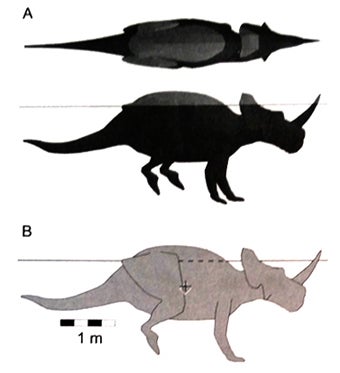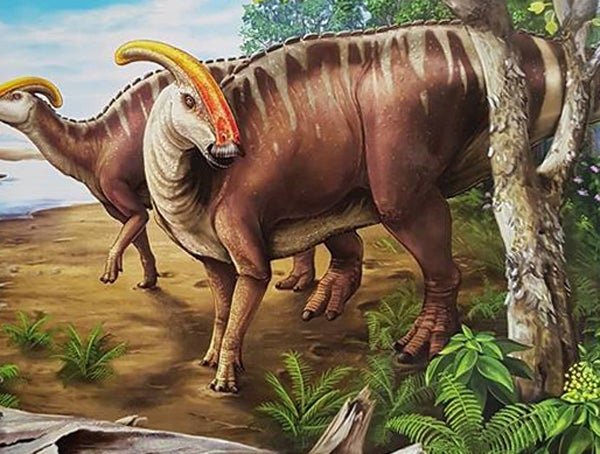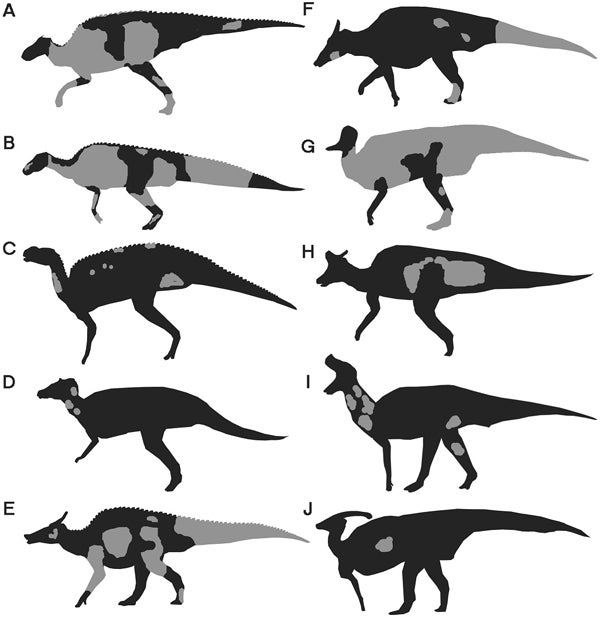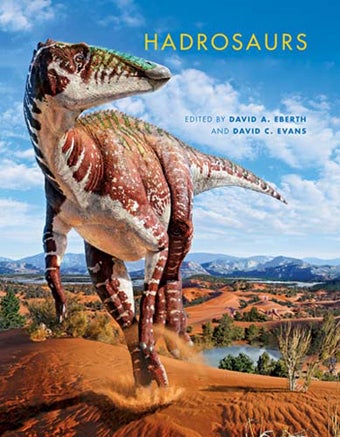This article was published in Scientific American’s former blog network and reflects the views of the author, not necessarily those of Scientific American
Here’s the second part of my review of the Indiana University Press 2014 book Hadrosaurs, edited by David Eberth and David Evans. For the first part of the review please go here.
Running, swimming, chewing. Several of the book’s contributions on palaeobiology are especially interesting. W. Scott Persons and Philip Currie examine the role of the caudofemoralis in hadrosaurs and what it might mean for running and escape behaviour. They propose that hadrosaur morphology might not permit greater sprint speeds than those of their primary predators (tyrannosaurids), but that greater endurance is suggested by the positions of the muscle insertions.

Henderson’s digital modelling of a floating Centrosaurus indicates that ceratopsids were likely not great swimmers. Credit: Henderson 2014, in Eberth & Evans 2014
On supporting science journalism
If you're enjoying this article, consider supporting our award-winning journalism by subscribing. By purchasing a subscription you are helping to ensure the future of impactful stories about the discoveries and ideas shaping our world today.
Donald Henderson’s ‘Duck soup: the floating fates of hadrosaurs and ceratopsians at Dinosaur Provincial Park’ describes his use of digital modelling in determining the possible floating postures of both hadrosaurs and ceratopsians. Hadrosaurs may well have been capable swimmers, easily capable of keeping the head clear of the water, but the same can’t be said for ceratopsids. If Don’s models are right, the latter would appear utterly maladapted for swimming or floating and pre-disposed for drowning. This might be the final nail in the coffin for Lehman’s proposal that some ceratopsids (like Agujaceratops) lived amphibious, hippo-like lives (Lehman 2007), a view inconsistent with other lines of evidence anyway.

I haven't mentioned the very fine piece of art – by Danielle Dufault – that appears on the back cover. This is a cropped section of the whole thing. The two Parasaurolophus individuals depicted here are acting like a male and female of the same species... but they actually represent two distinct species that were separated in space and time. Credit: Eberth & Evans 2014
Ali Nabavizadeh discusses hadrosaur jaw function, his model involving a palinal jaw movement (this meaning that the lower jaw is pulled backwards relative to the rest of the skull) and medial rotation of the dentaries. That latter idea has variously been in and out of fashion over the decades; its presence is surely required given that the pleurokinetic model (involving lateral rotation of the maxilla) is now essentially disproven (e.g., Holliday & Witmer 2008, Cuthbertson et al. 2012).
Taphonomy: bonebeds and soft tissues. In the final section of the book, James Schmitt et al. discuss an assemblage where sediment resulting from a debris flow event entombs hadrosaur bones. This looks like a case where unlucky hadrosaurs died in catastrophic fashion linked to a volcanic eruption… but, no. Other mass death assemblages are described in studies on the Dinosaur Park Formation and Zhucheng in Shandong Province, China.

Hadrosaur fossils belonging to several different lineages have large amounts of skin preserved, as shown here in Phil Bell’s diagram, from Bell (2014). Credit: Bell 2014, in Eberth & Evans 2014
A review of hadrosaur pathologies is provided by Darren Tanke and Bruce Rothschild. The volume ends with a really useful overview of our knowledge on hadrosaur skin impressions by Phil Bell, a chapter on soft tissue nasal structures in a mummified Edmontosaurus specimen by Albert Prieto-Márquez and Jonathan Wagner, and another by Phillip Manning et al. on the biochemistry of preserved hadrosaur skin. That preserved ‘skin’ on the mummies really is actual skin (rather than mere impressions of it), and it seems to even preserve the chemical traces associated with pigments.
Those of us interested in and involved in science appreciate ‘good science’. But a guilty pleasure that at least some of us admit to is that we also quite enjoy checking out bad papers: those that employ spurious or highly dubious argumentation, propose a weird, ‘non-standard’ model that doesn’t fit the bulk of evidence, or are just nuts. And yet… Hadrosaurs does not include any such article, and I leave it to you to decide whether this is a good thing or a bad thing.

Cover of Eberth & Evans (2014). A Djadokhta Formation scene, featuring Plesiohadros, is on the cover; art by Julius Csotonyi. Credit: Indiana University Press
I am, overall, impressed with Hadrosaurs. Well designed, handsome and fantastically well edited (credit there to Patricia Ralrick), congratulations are deserved to the editors for pulling together a vast amount of content, and doing it well. The book contains a huge quantity of information on these dinosaurs and reflects the state of play as of 2014-ish: many of the discussions on phylogeny, new taxa, anatomy, functional morphology, biogeography, taphonomy and more will need to be consulted and cited by specialists. The book is emphatically not, however, a review of hadrosaur diversity and biology as a whole (not that it was intended to be), and its price in hardcopy is high, so it’s not intended for non-specialists. The inevitable question, then, is: when will a good, non-technical review volume – something on par with Dodson’s The Horned Dinosaurs (Dodson 1996) or Hallett and Wedel’s The Sauropod Dinosaurs (Hallett & Wedel 2016) – appear on this group?
Eberth, D. A. & Evans, D. C. 2014. Hadrosaurs. Indiana University Press, Bloomington & Indianapolis, pp. 619. ISBN 978-0-253-01385-9. Here from the publishers.Here on amazon.Here on amazon.co.uk.
For previous Tet Zoo article on hadrosaurs and other iguanodontians, see…
Early abelisaurs and fan-crested and stretch-jawed hadrosaurs
Pads and notches in the necks of tube-crested hadrosaurs… SAY WHAT?
There are dwarf, island-dwelling, cursorial, tridactyl hadrosaurs now: didn’t you get the memo?
The explosion of Iguanodon, part 2: Iguanodontians of the Hastings Group
Refs - -
Bell, P. R. 2014. A review of hadrosaurid skin impressions. In Eberth, D. A. & Evans, D. C. 2014. Hadrosaurs. Indiana University Press, Bloomington & Indianapolis, pp. 572-590.
Cuthbertson, R. S., Tirabasso, A., Rybczynski, N. & Holmes, R. B. 2012. Kinetic limitations of intracranial joints in Brachylophosaurus canadensis and Edmontosaurus regalis (Dinosauria: Hadrosauridae), and their implications for the chewing mechanics of hadrosaurids. Anatomical Record 295, 968-979.
Dodson, P. 1996. The Horned Dinosaurs. Princeton University Press, Princeton, NJ.
Holliday, C. M. & Witmer, L. M. 2008. Cranial kinesis in dinosaurs: intracranial joints, protractor muscles, and their significance for cranial evolution and function in diapsids. Journal of Vertebrate Paleontology 28, 1073-1088.
Lehman, T. M. 2007. Growth and population age structure in the horned dinosaur Chasmosaurus. In Carpenter, K. (ed) Horns and Beaks: Ceratopsian and Ornithopod Dinosaurs. Indiana University Press (Bloomington & Indianapolis), pp. 259-317.